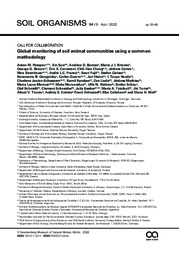Global monitoring of soil animal communities using a common methodology.
Global monitoring of soil animal communities using a common methodology.
Author(s): POTAPOV, A. M.; SUN, X.; BARNES, A. D.; BRIONES, M. J. I.; BROWN, G. G.; CAMERON, E. K.; CHANG, C.-H.; CORTET, J.; EISENHAUER, N.; FRANCO, A. L. C.; FUJII, S.; GEISEN, S.; GONGALSKY, K. B.; GUERRA, C.; HAIMI, J.; HANDA, I. T.; JANION-SCHEEPERS, C.; KARABAN, K.; LINDO, Z.; MATHIEU, J.; MORENO, M. L.; MURVANIDZE, M.; NIELSEN, U. N.; SCHEU, S.; SCHMIDT, O.; SCHNEIDER, C.; SEEBER, J.; TSIAFOULI, M. A.; TUMA, J.; TIUNOV, A. V.; ZAITSEV, A. S.; ASHWOOD, F.; CALLAHAM, M.; WALL, D. H.
Summary: Here we introduce the Soil BON Foodweb Team, a cross-continental collaborative network that aims to monitor soil animal communities and food webs using consistent methodology at a global scale. Soil animals support vital soil processes via soil structure modification, consumption of dead organic matter, and interactions with microbial and plant communities. Soil animal effects on ecosystem functions have been demonstrated by correlative analyses as well as in laboratory and field experiments, but these studies typically focus on selected animal groups or species at one or few sites with limited variation in environmental conditions. The lack of comprehensive harmonised large-scale soil animal community data including microfauna, mesofauna, and macrofauna, in conjunction with related soil functions, microbial communities, and vegetation, limits our understanding of biological interactions in soil systems and how these interactions affect ecosystem functioning. To provide such data, the Soil BON Foodweb Team invites researchers worldwide to use a common methodology to address six long-term goals: (1) to collect globally representative harmonised data on soil micro-, meso-, and macrofauna communities, (2) to describe key environmental drivers of soil animal communities and food webs, (3) to assess the efficiency of conservation approaches for the protection of soil animal communities, (4) to describe soil food webs and their association with soil functioning globally, (5) to establish a global research network for soil biodiversity monitoring and collaborative projects in related topics, (6) to reinforce local collaboration networks and expertise and support capacity building for soil animal research around the world. In this paper, we describe the vision of the global research network and the common sampling protocol to assess soil animal communities and advocate for the use of standard methodologies across observational and experimental soil animal studies. We will use this protocol to conduct soil animal assessments and reconstruct soil food webs at sites associated with the global soil biodiversity monitoring network, Soil BON, allowing us to assess linkages among soil biodiversity, vegetation, soil physico-chemical properties, climate, and ecosystem functions. In the present paper, we call for researchers especially from countries and ecoregions that remain underrepresented in the majority of soil biodiversity assessments to join us. Together we will be able to provide science-based evidence to support soil biodiversity conservation and functioning of terrestrial ecosystems.
Publication year: 2022
Types of publication: Journal article
Unit: Embrapa Forestry
Observation
Some of Embrapa's publications are published as ePub files. To read them, use or download one of the following free software options to your computer or mobile device. Android: Google Play Books; IOS: iBooks; Windows and Linux: Calibre.
Access other publications
Access the Agricultural Research Database (BDPA) to consult Embrapa's full library collection and records.
Visit Embrapa Bookstore to purchase books and other publications sold by Embrapa.

